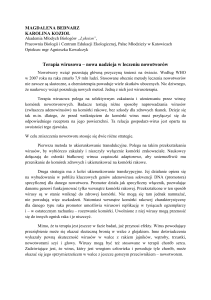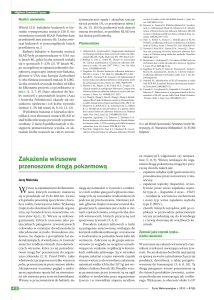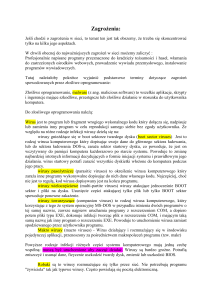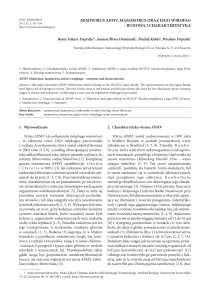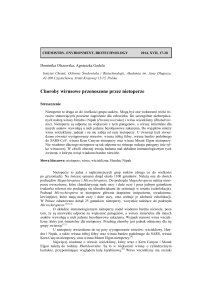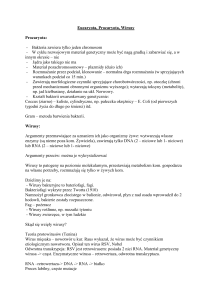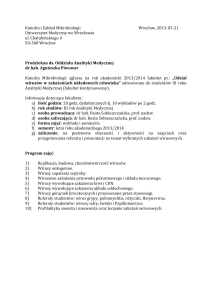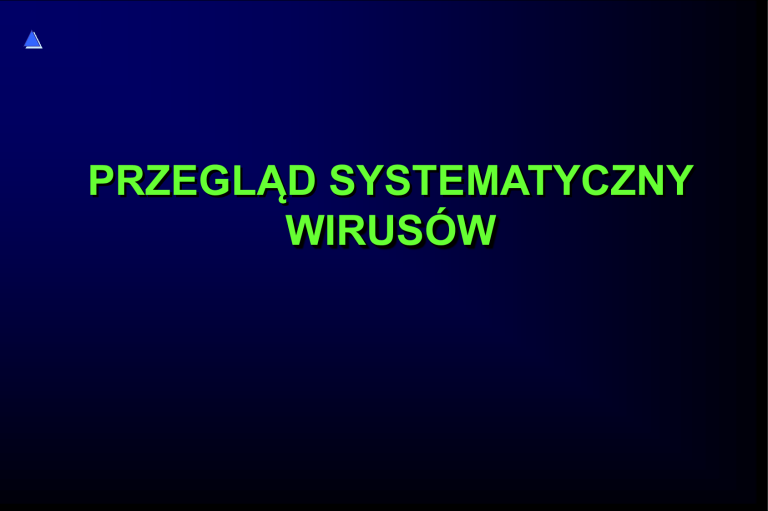
PRZEGLĄD SYSTEMATYCZNY
WIRUSÓW
DNA-containing viruses
Adenoviridae
Adenovirus A colorized electron
micrograph from the Center for Cell
Imaging at the Yale University School
of Medicine.
DNA-containing viruses
Adenoviridae
ZAWIERAJĄ DWUNICIOWY DNA
WIRIONY NIE MAJĄ OSŁONKI
ZAKAŻENIE KOMÓRKI: endocytoza – odpłaszczenie, doprowadzenie jądra
wirusa do jądra komórki, mRNA, transkrypcja, transkrypcja, odtworzenie
wirusowego DNA, odbudowa wirionów potomnych
SYNTEZA WIRIONÓW W JĄDRZE KOMÓRKI
WYIZOLOWANY DNA – ZAKAŹNY
Procesy chorobowe umiejscowione głównie w układzie oddchowym i
pokarmowym
Przebieg zakażeń bezobjawowy lub nieznaczne objawy kliniczne
Dotyczy zwykle dzieci (główny rezerwuar)
47 serotypów
DNA-containing viruses
Adenoviridae
DIAGNOSTYKA WIRUSOLOGICZNA
2.
3.
4.
IZOLACJA Z WYMAZÓW GARDŁA,WYDZIELIN SPOJÓWEK,
PLWOCINY,KAŁU
DODANIE DO WYIZOLOWANEGO MATERIAŁU ANTYBIOTYKÓW
ZAKAŻANIE KOMÓREK (HeLa, KOM. ZARODKA LUDZKIEGO)
OBSERWACJA ZMIAN CYTOPATYCNYCH PO 2 – 21 DNIACH
1.
2.
3.
4.
5.
IDENTYFIKACJA WIRUSA
ODCZYN WIĄZANIA DOPEŁNIACZA
ODCZYN ZOBOJĘTNIANIA
ELEKTROFOREZA
HYBRYDYZACJA
IFA
1.
ADENOVIRUS
DNA-containing viruses
Papovaviridae
MAŁE WIRIONY Z DWUICIOWYM DNA
BRAK OSŁONKI
ZAKAŻENIEPROWADZI DO NISZCZENIA KOMÓRKI LUB
ZAKAŻENIE CIĄGŁE PROWADZI DO TRANSFORMACJI
KOMÓREK I ROZWOJU PROCESU NOWOTWOROWEGO
REPLIKACJA DNA I DOJRZEWANIE ZACHODZI W JĄDRZE
OGRANICZONY ZAKRES GOSPODARZY
Papovaviridae: Porównanie wirusów z rodzajów Polyomavirus i Papillomavirus
Papovaviridae
Papillomawirusy:
swoistość gatunkowa żywicieli
znanych 100 typów ludzkich wirusów
komórkami docelowymi są kom. warstw rozrodczych skóry i błon
śluzowych (efektem są brodawki)
Poliomawirusy (SV 40, Py, BKV, JCV):
wirusy powiązane z etiologią nowotworów
DNA-containing viruses
Papovaviridae
Papillomavirus particles are approximately 55nm in diameter.
The capsid is composed of 72 morphological units, or capsomers, arranged on the surface of
a T=7 icosahedron. The capsomers located at each of the 12 vertices, are pentavalent (i.e.
each is surrounded by five adjacent capsomers), and the other 60 capsomers are
hexavalent (each adjacent to six capsomers).
DNA-containing viruses
PAPILLOMAVIRUS
DNA-containing viruses
Papillomavirus
Many types of papillomavirus cause benign skin tumours (warts) in their natural hosts. These
warts often regress spontaneously, but human genital warts (tumours caused by specific
types of papillomavirus, particularly types 16 and 18) regularly become malignant if they persist for a
sufficiently long time
.
HUMAN PAPILLOMAVIRUS
MULTIPLE HUMAN PAPILLOMAVIRUSES
DNA-containing viruses
Bovine papilloma
DNA-containing viruses
Herpesviridae
JEDNA CZĄSTECZKA LINIOWEGO, DWUNICIOWEGO DNA
OSŁONKA Z PODWÓJNEJ WARSTWY LIPIDOWEJ I GLIKOPROTEINOWEJ
POMIĘDZY OSŁONKĄ, A KAPSOMEREM JEST WARSTWA BIAŁKOWA
OSŁONKA ZAWIERA ANTYGENY WIĄŻĄCE SWOISTE PRZECIWCIAŁA
NEUTRALIZUJĄCE WIRUSA I RECEPTOR DLA Fc FRAGMENTU
IMMUNOGLOBULIN
Wirus Herpes simlex typu 1 i 2, wirus ospy wietrznej, wirus małpiB
Wirus cytomegalii, wirus herpes typu 6
Wirus Epstaina – Barr,wirusy herpes typu 7 i 8
DNA-containing viruses
HERPESVIRUS
DNA-containing viruses
Hepadnaviridae
DNA-containing viruses
HBV is the prototype member of the family Hepadnaviridae
HEPATITIS B VIRUS
DNA-containing viruses
Parvoviridae
Podrodziny:
Parvovirinae
Wirusy kręgowców
zależne od adenowirusów
(defektywne))
najmniejsze DNA wirusy
liniowy jednoniciowy DNA (+)
DNA-containing viruses
Densovirinae
Wirusy bezkręgowców
Parvoviridae
Wywołują liczne choroby u zwierząt,związane z
niszczeniem kom.proliferujących, prowdzące do
uskodzeń płodu i noworodków.
U ludzi wiąże się etiologicznie rozwój rumienia
zakaźnego typu B 19 oraz stany podbiegunkowe
o niewyjaśnionej etiologii.
DNA-containing viruses
FAMILIAE: Parvoviridae
DNA-containing viruses
PARVO VIRUS
DNA-containing viruses
RNA-containing viruses
RNA-containing viruses
Orthomyxoviridae
Zakażenia oddechowe
Wirusy A mogą zakażać zwierzęta i ludzi, wirusy B
zakażają tylko ludzi
RNA-containing viruses
INFLUENTZA VIRUS
Reoviridae
RNA-containing viruses
DWUNICIWY, LINIOWY RNA
BRAK OSŁONKI
WYSTĘPUJE 6 – 10 GŁÓWNYCH POLIPEPTYDÓW
STRUKTURALNYCH, TRANSKRYPTAZA I INNE ENZYMY
REPLIKACJA W CYTOPLAZMIE
WIRUSY WYWOŁUJĄCE LIZĘ
Reoviridae
RNA-containing viruses
Zakażenia niemowląt i małych dzieci (do 2 roku życia) –
wiele jest zakażeń bezobjawowych. W zakażeniach
objawowych okres unkubacji 1 – 3 dni. Charakterystyczne
są wymioty, biegunka, podwyższenie temperatury i ból
brzucha.
U dorosłych zaburzenia jelitowe
RNA-containing viruses
RNA-containing viruses
Reoviridae
ROTAVIRUS
Human rotavirus
RNA-containing viruses
Reoviridae
An animal reovirus
Mammalian reovirus
virion
Note the wheel-like appearance of some of the
rotavirus particles. The observance of such particles
gave the virus its name ('rota' being the Latin word
meaning wheel). Bar = 100 nanometers. Source:
Cell culture. Method: Negative-stain Transmission
Electron Microscopy
By F.P. Williams, U.S. Environmental Protection
Agen
RNA-containing viruses
Parmyxoviridae
DUŻE WIRUSY (150 nm)
PLEOMORFIZM
JEDNA CZĄSTECZKA RNA (-)
MAJA OSŁONKĘ
WIRIONY MAJĄ 5 – 7 GŁÓWNYCH POLIPEPTYDÓW
REPLIKACJA W CYTOPLAZMIE
UWALNIANIE PRZEZ PĄCZKOWANIE
SWOISTOŚĆ GATUNKOWA
RNA-containing viruses
Parmyxoviridae
Wirus parainfluezy
Wirus odry
Wirus nagminnego zapalenia ślinianek
przyusznych
RNA-containing viruses
PARAMYXOVIRIDAE
Newcastle disease virus
Genus: Rubulavirus
Family: Paramyxoviridae
Virion: pleomorphic round forms 100-500
nm in diameter,
filamentous forms 100150 nm across.
Nucleocapsid:
herringbone pattern of
subunits, 18 nm across
pitch 5.5 nm. ssRNA,
15,156 nucleotides.
Envelope: lipoprotein
bilayer contains
projections of F and the
larger HN (8 nm).
RNA-containing viruses
PARAMYXOVIRUSES
RNA-containing viruses
Picornaviride
RNA (+), JEDNOPASMOWY
BRAK OSŁONEK
SYNTEZA WIRIONÓW W CYTOPLAZMIE
RNA-containing viruses
Picornaviride
Enterowirusy (poliowirusy, wirusy Coxackie
typu A i B, wirusy ECHO)
Hepatowirusy (HAV)
Rhinovirus
Cardiovirus
Aphtovirus
RNA-containing viruses
ENTEROVIRUSES
Picornaviridae
RNA-containing viruses
Viral particles seen by transmission
electron microscopy (TEM) at a
magnification of 350,000x). This
image is from Dennis Kunkel's
excellent Microscopy Science and
Photography Through a Microscope
web site.
Human poliovirus 1
Human poliovirus
An animal picornavirus
Human hepatitis A virus
RNA-containing viruses
Flaviviridae
RNA (+) JEDNOPASMOWY
LIPIDOWA OSŁONKA
2 – 3 BIAŁKA ZWIĄZANE Z OSŁONKĄ
W WIRIONACH DUŻO LIPIDÓW POCHODZENIA
KOMÓRKOWEGO
SĄ GLIKOPROTEINY I GLIKOLIPIDY
REPLIKACJA W CYTOPLAZMIE
DOJRZEWANIE W WODNICZKACH I SIATECZCE
ŚRÓDPLAZMATYCZNEJ
ROZPRZESTRZENIANIE PRZY UDZIALE WEKTORÓW
RNA-containing viruses
Flaviviridae
FLAVIVIRUS
PESTIVIRUS
Retroviridae
RNA-containing viruses
Representation of the Human Immunodeficiency Virus
HIV


